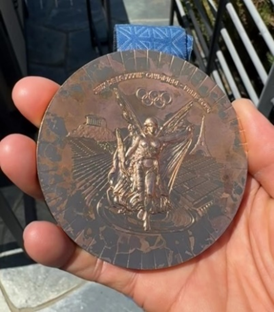What is Gold Medal Worthy Plating?
Upon the completion of a standard plating job, a shop is generally looking at three main properties: visual workmanship, deposited thickness, and overall plating adhesion. When considering workmanship criteria, an inspector would typically consider physical appearance by identifying visible imperfections. These imperfections include (but are not limited to) pits/burns/shadows, bare spots, roughness, etc.
 |
Thickness of the deposit directly relates to how protective or enhancing the coating will be. Perhaps the most critical of these three properties is adhesion of the plated layer. This critical property came to the forefront of discussions during the recently concluded Olympics after many medalists noticed their hard-earned awards were peeling only days after received them. The final finished product can be the most visually stunning piece with sufficient thickness, but if it doesn’t stick, that’s a failure! |
While there may be a great many more steps that are required in the successful plating of a given item, all “coating” projects share the importance of their very first step. Whether it’s staining the deck on your house, repainting your child’s bedroom, or bronze plating Nijah Houston’s Olympic medal, surface preparation is paramount. While your deck needs a good power wash and the bedroom walls need an even sanding, a newly machined item needs the removal of machining fluids, lubricants, and rust preventative compounds. Steps to do so may include vapor degreasing, solvent wiping, alkaline soak cleaning or anodic electrocleaning. Immediately following these processes is typically an acidic dip to neutralize the previous cleaning and also remove oxides such as rust on a steel material or natural oxide on aluminum. While these two steps are usually all that’s required for steel or brass, most materials such as stainless steel, aluminum, plastics or titanium require specialized activation to ensure proper adhesion of subsequently applied layers.
| Once a plating is applied, how does the plater ensure that it is adherent? This can be a challenge. Blisters and peeling aren’t always readily apparent. Adhesion testing can be destructive so it can’t be done on an entire lot of parts. Often, we plate surrogate test coupons with the parts and destructive test those via bend-to-break or grid scribe method as detailed in ASTM B571. However, the results on those witness coupons can be deceiving, as they may not perfectly represent the surface of the actual part. We only stock about 8 such test coupon materials, so if you have an unusual alloy or heat treatment callout, it’s best to supply your own coupons that better represent the surface condition of the actual parts. One non-destructive adhesion test per ASTM B571 is the bake and quench test. It involves heating parts and then cooling them, followed by visual examination for any signs of compromised adhesion. While useful in some cases, it may not be a discerning as one of the destructive test methods. |  |
Despite various testing techniques used to sort out plating adhesion failures, they can and do still occur. Rather than focus on best practices for inspecting and detecting poor adhesion, it’s always more critical to emphasize strict process control over cleaning and activation steps to assure a gold medal worthy finish every time.













